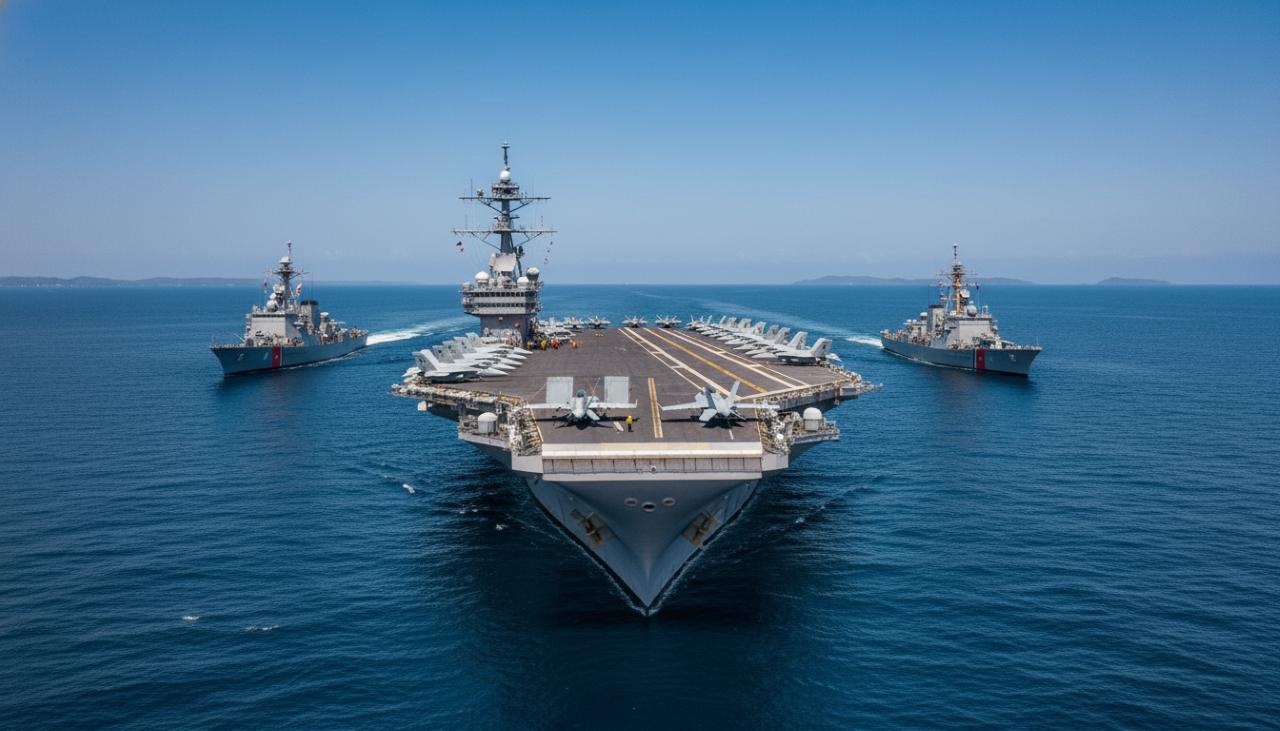
The Pentagon is moving the USS Gerald R. Ford and its escorts into U.S. Southern Command, after months of stepped‑up air and naval operations in the Caribbean and eastern Pacific and a string of deadly strikes on alleged “drug boats.”
The administration says this is about narcotics. The assets, tempo, and rhetoric tell a different story: coercive leverage aimed at Venezuela, wrapped in drug-war branding.
The Escalation That Already Happened
For weeks, the strike tempo has quickened from sporadic to routine. Night attacks on small craft. Death tolls tallied by post, not by court case. Heavy bombers cruising the Venezuelan littoral. ISR and drones forward-positioned. A submarine confirmed in theater. Now a full carrier strike group on the way. This is not Coast Guard boarding and seizure; it’s kinetic deterrence with a political target in mind.
The carrier matters. A Ford-class deck doesn’t “interdict” one go-fast at a time. It brings air dominance, command-and-control, and a floating forward base that can surge sorties, collect intelligence, and coordinate joint assets across a wide arc. You send that when you want options—visible, flexible, and escalatory.
The Stated Mission Doesn’t Match The Means
If this were primarily about drug flows into the United States, you would prioritize:
- Persistent maritime patrols and seizures with evidence chains
- Financial sanctions and corruption cases that collapse networks
- Partner-led arrests, extraditions, and judicial cooperation
- Demand-side policy at home that reduces market pull
You wouldn’t lead with a carrier and a legal theory that treats traffickers as combatants on the high seas. The drug routes themselves undercut the talking points: fentanyl overwhelmingly transits overland via Mexico; cocaine pipelines adapt quickly, and the Caribbean leg is not the main artery into U.S. streets. Precision strikes on skiffs look decisive but deliver thin systemic returns and almost no exploitable intel.
The Real Play: Pressure Caracas
Strip away the euphemisms and you see the logic. The buildup concentrates near Venezuela. The administration has already acknowledged CIA covert authorities in the country. Public messaging increasingly conflates cartels with “narco‑terrorists” and ties multiple strikes to a Venezuelan-origin gang. That is classic gray‑zone coercion: signal capability, rattle the officer corps, pry at loyalties, and raise the perceived cost of staying with Maduro. You don’t need to invade to change a regime’s calculus; you need to convince key insiders that time and firepower are not on their side.
It’s also why this approach is dangerous. The more you frame a domestic criminal threat as an “armed conflict,” the more elastic your target set becomes—and the easier it is to slide from coastal interdiction to inland strikes, sabotage, renditions, or “smash-and-grab” arrests justified after the fact. One tragic misidentification or civilian casualty at sea becomes a regional incident. One nervous intercept near Venezuelan airspace can spiral.
Democratic Guardrails Are Not Optional
A president unilaterally declaring non‑state criminals “unlawful combatants” and deploying the world’s most advanced carrier into the hemisphere’s busiest political minefield tests the limits of both domestic and international law. The response shouldn’t be performative outrage; it should be institutional.
- Demand a tailored authorization for use of military force. If this is an “armed conflict,” define the enemy, theater, reporting, oversight, and a sunset. That’s how a constitutional democracy wages force, full stop.
- Impose civilian‑harm, detention, and after‑action transparency standards. Counting corpses on social media isn’t accountability.
- Recenter the interagency: Coast Guard for maritime law enforcement, Treasury and Justice for network takedown, State for coalition-building. The Pentagon supports; it doesn’t subsume.
The Regional Politics Will Decide The Outcome
Latin American governments have long memories. Even partners blanch at unilateral kinetic operations under a counter‑narco banner. If Brasília, Bogotá, Mexico City, and Caribbean states perceive this as regime‑change politics in drug-war clothing, basing, overflight, extraditions, and intelligence sharing will tighten up fast. That’s the test ahead: do regional capitals see a cooperative security effort—or a made‑for‑TV show of force that treats their sovereignty as a prop?
What Competence Would Look Like
- Publish real metrics. Not “boats hit,” but route displacement, wholesale price/purity shifts, case closures, corruption convictions, overdose trends. If a carrier is part of a results chain, prove it.
- Use the big stick sparingly and visibly within law. Carrier aviation for time‑sensitive, high‑value missions with partner consent and immediate congressional notification. Everything else: Coast Guard, task forces, prosecutors, and financial intelligence.
- Keep the aperture on Venezuela political, not kinetic. If the aim is leverage, build a sanctions‑relief off‑ramp tied to verifiable reforms rather than daring Caracas to miscalculate.
The choice to send the Ford is not incremental. It’s an unmistakable political signal layered onto months of escalation and the public admission of covert action authorities in Venezuela. If the United States is going to recast counternarcotics as counterinsurgency on the Caribbean’s doorstep, it owes the country an open debate, legal clarity, and a strategy that reduces harm rather than courting it.
